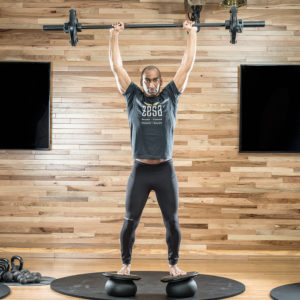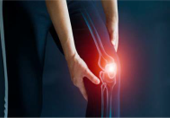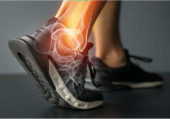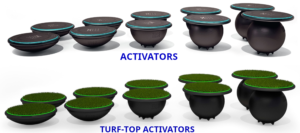LIFE IS TOO DYNAMIC TO TRAIN STATIC
INJURIES ARE PREVENTABLE – Most training doesn’t include secondary stabilizing muscles that provide balance, stability, and joint strength to prevent injuries.[i] [ii] Balance-Strength™ training can reduce injury rates and accelerate injury rehabilitation.[iii]
 DEVELOP YOUR BRAIN – In an unstable yet controlled environment your brain learns to manipulate your body to produce the right movement with the right force at the right time.[iv] Progressive unstable training contributes to growth of new brain cells & neural executive functions that help with planning, problem solving, and behavior control.[v] [vi] [vii] [viii]
DEVELOP YOUR BRAIN – In an unstable yet controlled environment your brain learns to manipulate your body to produce the right movement with the right force at the right time.[iv] Progressive unstable training contributes to growth of new brain cells & neural executive functions that help with planning, problem solving, and behavior control.[v] [vi] [vii] [viii]
 BUILD MUSCLE –
BUILD MUSCLE –  Unstable training increases muscle activation by up to 47%, and increases core strength by up to 24%.[xi] [x] [xi]
Unstable training increases muscle activation by up to 47%, and increases core strength by up to 24%.[xi] [x] [xi]
 HEALTH IMPROVEMENTS – Balance-Strength™ is a greater indicator of fitness, and more important in preventing injury over primary muscle strength, flexibility, and cardio – but little attention is paid to it in training.[xii] Balance-Strength™ training generates many health improvements and is linked to greater longevity and overall quality of life.[xiii]
HEALTH IMPROVEMENTS – Balance-Strength™ is a greater indicator of fitness, and more important in preventing injury over primary muscle strength, flexibility, and cardio – but little attention is paid to it in training.[xii] Balance-Strength™ training generates many health improvements and is linked to greater longevity and overall quality of life.[xiii]

 COOL GEAR – Society lacks cutting-edge, low-cost, Balance-Strength™ analysis, training, & rehab gear that can simply be used by anyone, anywhere, at any level. ZeSa’s Dynamic Balance-Strength Training System™ solves this problem.
COOL GEAR – Society lacks cutting-edge, low-cost, Balance-Strength™ analysis, training, & rehab gear that can simply be used by anyone, anywhere, at any level. ZeSa’s Dynamic Balance-Strength Training System™ solves this problem.
– For Further Insight Please Read Below –
The Balance-Strength™ Problem:
-
Loss of balance starts in our 20’s, amplifies falls and injury probability, and lowers quality of life and longevity unless we counteract it.[xiv]
-
Musculoskeletal injury rates are high, and costs of lost income, surgery, medical care, and rehab are over $600B annually in the USA at an average of $64K per occurrence.[xv]
-
Current training & rehab methods & equipment should reduce injuries & severity by uniformly building all layers of joint reinforcing muscles, but most focus mainly on primary muscles and not the critical secondary stabilizing muscles.[xvi] [xvii]
-
No easy low-cost measurement system exists for measuring Balance-Strength™ capability of individuals.
-
Balance-Strength™ training gear must provide increasing challenge for users to continually advance their Balance-Strength™ abilities. Existing gear covers very narrow user ability ranges, which highly limits its usefulness.[xviii]
-
Existing Balance-Strength™ training systems work in only 2 planes of motion, missing the critical 3rd rotational motion plane that benefits joint muscle & core rotation stability.[xix] [xx]
-
Existing balance training systems do not continually and progressively challenge brain-to-muscle connections, proprioception, brain cognition, and reactive balance capabilities – important components of the Balance-Strength™ matrix.[xxi]
The Balance-Strength™ Solution:
-
The ZeSa® Dynamic Balance-Strength Training System™ advances fitness by engaging a variety of dynamic balance challenge exercises with progressive increasing difficulty.[xxii]
-
ZeSa’s Balance-Strength Analysis™ & Balance-Strength Training™ apps provide easy methods to analyze and track your Balance-Strength capabilities and progress, and to carry out pre-made or custom training sessions of your choice for focus on your desired training goals.
-
ZeSa’s system trains “Reactive Balance” with movements that challenge the body when rapid motion changes and balance challenge occur. This requires mental focus that strengthens brain neural pathways & stabilizing muscles (groups of muscles that maintain proper posture and joint alignment during movement). It mimics real world scenarios like rough terrain, uneven surfaces, slippery ice, and all dynamic sports in a safe and controlled environment to aid Balance-Strength™ and injury prevention. [xxiii] [xxiv] [xxv]
-
Functional training is important for fitness enthusiasts because it focuses on exercises that replicate movements used in daily life, thereby enhancing overall fitness and reducing the risk of injury in recreational sports and other activities.[xxvi]
-
Training with ZeSa’s System increases the benefits of functional training while simultaneously creating a true mind/body connection. It forces the body to engage and activate both the brain and all layers of muscles. Studies show this type of training can increase muscle activation by up to 47%,[xxvii] [xxviii] and reduce the risk of injury in recreational sports by up to 50% while improving performance.[xxix]
-
Studies show performing exercises unstable can increase core strength by up to 24% over traditional training. [xxx] The core muscles (abs, obliques, lower back) are the center foundation of the body, stabilize the spine and pelvis, and allow for efficient transfer of force and energy during movements. [xxxi]
Health Improvements:
-
Regular Use Strengthens & Stabilizes Joints & Reduces Occurrence/Severity of Injury
-
Provides Improved Injury Recovery & Balance-Strength™ that Reduces Re-Injury
-
Challenges & Improves Balance-Strength™ for Overall Body Fitness
-
Activates All Muscle Layers For Maximum Muscle Recruitment & Joint Stabilization
-
Deeply Engages Core And Joint Stabilization Muscles
-
Improves Quality of Life & Longevity, and it is Easy & Fun to Use
Saves $$:
-
Reduce Injury Rates & Save $ Losses to Athletes, Teams, Corporations, & Society
-
Speed Up Joint Injury Recovery & Surgery Rehab & Reduce Down Time – Save $
-
Reduce Medical Costs to Individuals, Teams, & Insurance Companies
-
Low-Cost Solution – Affordable Equipment Price Points
-
ZeSa Equipment Works with Existing Gym Equipment – Weights, Racks, Balls, Ropes, Straps, Mats, Etc.
[i] Huxel Bliven KC, Anderson BE. Core stability training for injury prevention. Sports Health. 2013 Nov;5(6):514-22. doi: 10.1177/1941738113481200. PMID: 24427426; PMCID: PMC3806175.
[ii]https://www.researchgate.net/publication/341030419_SQUATS_PERFORMED_ON_AN_UNSTABLE_SURFACE_ELICIT_HIGHER_TRANSVERSAL_FORCE_OUTPUT_COMPARED_TO_MORE_STABLE_SQUATS
[iii] Hübscher M, Zech A, Pfeifer K, Hänsel F, Vogt L, Banzer W. Neuromuscular training for sports injury prevention: a systematic review. Med Sci Sports Exerc. 2010 Mar;42(3):413-21. doi: 10.1249/MSS.0b013e3181b88d37. PMID: 19952811.
[iv] NASM Essentials of Personal Fitness Training, 7th Edition, Chapter 7: Intro to Human Movement Science.
[v] Behm, D. G., & Colado, J. C. (2012). The effectiveness of resistance training using unstable surfaces and devices.
for rehabilitation. International Journal of Sports Physical Therapy, 7(2), 226–241.
[vi] Rogge AK, Röder B, Zech A, Hötting K. Exercise-induced neuroplasticity: Balance training increases cortical thickness in visual and vestibular cortical regions. Neuroimage. 2018 Oct 1;179:471-479. doi: 10.1016/j.neuroimage.2018.06.065. Epub 2018 Jun 26. PMID: 29959048.
[vii] Taube W, Gruber M, Gollhofer A. Spinal and supraspinal adaptations associated with balance training and their functional relevance. Acta Physiol (Oxf). 2008 Jun;193(2):101-16. doi: 10.1111/j.1748-1716.2008.01850.x. Epub 2008 Mar 12. PMID: 18346210.
[viii] Eckardt N, Braun C, Kibele A. Instability Resistance Training improves Working Memory, Processing Speed and Response Inhibition in Healthy Older Adults: A Double-Blinded Randomised Controlled Trial. Sci Rep. 2020 Feb 13;10(1):2506. doi: 10.1038/s41598-020-59105-0. PMID: 32054896; PMCID: PMC7018952.
[ix] Behm, D. G., & Colado, J. C. (2012). The effectiveness of resistance training using unstable surfaces and devices for rehabilitation. International Journal of Sports Physical Therapy, 7(2), 226–241.
[x] Granacher U, Schellbach J, Klein K, Prieske O, Baeyens JP, Muehlbauer T. Effects of core strength training using stable versus unstable surfaces on physical fitness in adolescents: a randomized controlled trial. BMC Sports Sci Med Rehabil. 2014 Dec 15;6(1):40. doi: 10.1186/2052-1847-6-40. PMID: 25584193; PMCID: PMC4290805.
[xi] Bencke J, Strøm M, Curtis DJ, Bandholm T, Zebis MK. Differences in Thigh Muscle Activation Between Standing and Landing Exercises for Knee Injury Prevention and Rehabilitation. Int J Sports Phys Ther. 2023 Feb 1;18(1):102-112. doi: 10.26603/001c.67829. PMID: 36793578; PMCID: PMC9897038.
[xii] https://www.cnn.com/2022/06/21/health/balance-on-one-leg-longevity-wellness/index.html
[xiii] Dunsky A. The Effect of Balance and Coordination Exercises on Quality of Life in Older Adults: A Mini-Review. Front Aging Neurosci. 2019 Nov 15;11:318. doi: 10.3389/fnagi.2019.00318. PMID: 31803048; PMCID: PMC6873344.
[xiv] https://www.wellandgood.com/balance-and-longevity/
[xv] https://www.archives-pmr.org/article/S0003-9993(14)00031-8/fulltext
[xvi] HuxelBlivenKC, Anderson BE. Core stability training for injury prevention. Sports Health. 2013 Nov;5(6):514-22. doi: 10.1177/1941738113481200. PMID: 24427426; PMCID: PMC3806175.
[xvii] https://www.niams.nih.gov/health-topics/sports-injuries
[xviii] Wahl, Michael J; Behm, David G. Not All Instability Training Devices Enhance Muscle Activation in Highly Resistance-Trained Individuals. Journal of Strength and Conditioning Research 22(4):p 1360-1370, July 2008. | DOI: 10.1519/JSC.0b013e318175ca3c.
[xix] HuxelBlivenKC, Anderson BE. Core stability training for injury prevention. Sports Health. 2013 Nov;5(6):514-22. doi: 10.1177/1941738113481200. PMID: 24427426; PMCID: PMC3806175.
[xx] Majewska J, Kołodziej-Lackorzyńska G, Cyran-Grzebyk B, Szymczyk D, Kołodziej K, Wądołkowski P. Effects of Core Stability Training on Functional Movement Patterns in Tennis Players. Int J Environ Res Public Health. 2022 Nov 30;19(23):16033. doi: 10.3390/ijerph192316033. PMID: 36498108; PMCID: PMC9740142.
[xxi] Kim Y, VakulaMN, Bolton DAE, Dakin CJ, Thompson BJ, Slocum TA, TeramotoM, BresselE. Which Exercise Interventions Can Most Effectively Improve Reactive Balance in Older Adults? A Systematic Review and Network Meta-Analysis. Front Aging Neurosci. 2022 Jan 18;13:764826. doi: 10.3389/fnagi.2021.764826. PMID: 35115917; PMCID: PMC8804322.
[xxii] Fountaine, Charles Ph.D., FACSM. SHAREABLE RESOURCE: Ten Ways to Implement the Principle of Progressive Overload When Resistance Training. ACSM’s Health & Fitness Journal 26(2):p 70, 3/4 2022. | DOI: 10.1249/FIT.0000000000000740.
[xxiii] Chien, JE., Hsu, WL. Effects of Dynamic Perturbation-Based Training on Balance Control of Community-Dwelling Older Adults. Sci Rep 8, 17231 (2018). https://doi.org/10.1038/s41598-018-35644-5.
[xxiv] Kim Y, Vakula MN, Bolton DAE, Dakin CJ, Thompson BJ, Slocum TA, Teramoto M, Bressel E. Which Exercise Interventions Can Most Effectively Improve Reactive Balance in Older Adults? A Systematic Review and Network Meta-Analysis. Front Aging Neurosci. 2022 Jan 18;13:764826. doi: 10.3389/fnagi.2021.764826. PMID: 35115917; PMCID: PMC8804322.
[xxv] Lesinski M, Hortobágyi T, Muehlbauer T, Gollhofer A, Granacher U. Effects of Balance Training on Balance Performance in Healthy Older Adults: A Systematic Review and Meta-analysis. Sports Med. 2015 Dec;45(12):1721-38. doi: 10.1007/s40279-015-0375-y. Erratum in: Sports Med. 2016 Mar;46(3):457. doi: 10.1007/s40279-016-0500-6. PMID: 26325622; PMCID: PMC4656699.
[xxvi] Xiao W, Soh KG, Wazir MRWN, Talib O, Bai X, Bu T, Sun H, Popovic S, Masanovic B, Gardasevic J. Effect of Functional Training on Physical Fitness Among Athletes: A Systematic Review. Front Physiol. 2021 Sep 6;12:738878. doi: 10.3389/fphys.2021.738878. PMID: 34552511; PMCID: PMC8450457.
[xxvii] Behm DG, Leonard AM, Young WB, Bonsey WA, MacKinnon SN. Trunk muscle electromyographic activity with unstable and unilateral exercises. J Strength Cond Res. 2005 Feb;19(1):193-201. doi: 10.1519/1533-4287(2005)19<193:TMEAWU>2.0.CO;2. PMID: 15705034.
[xxviii] Batista GA, Beltrán SP, Passos MHPD, Calixtre LB, Santos LRH, de Araújo RC. Comparison of the Electromyography Activity during Exercises with Stable and Unstable Surfaces: A Systematic Review and Meta-Analysis. Sports (Basel). 2024 Apr 18;12(4):111. doi: 10.3390/sports12040111. PMID: 38668579; PMCID: PMC11055131.
[xxix] Belamjahad, A., Tourny, C., Jebabli, N. et al. Effects of a Preseason Neuromuscular Training Program vs. an Endurance-Dominated Program on Physical Fitness and Injury Prevention in Female Soccer Players. Sports Med – Open 10, 76 (2024). https://doi.org/10.1186/s40798-024-00731-7.
[xxx] Snarr RL, Hallmark AV, Nickerson BS, Esco MR. Electromyographical Comparison of Pike Variations Performed With and Without Instability Devices. J Strength Cond Res. 2016 Dec;30(12):3436-3442. doi: 10.1519/JSC.0000000000001436. PMID: 27191692.
[xxxi] Huxel Bliven KC, Anderson BE. Core stability training for injury prevention. Sports Health. 2013 Nov;5(6):514-22. doi: 10.1177/1941738113481200. PMID: 24427426; PMCID: PMC3806175.







